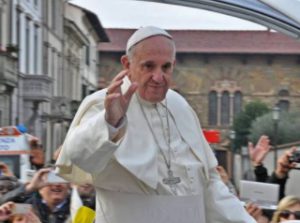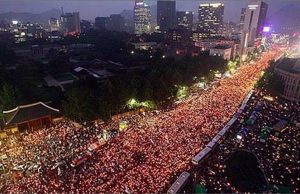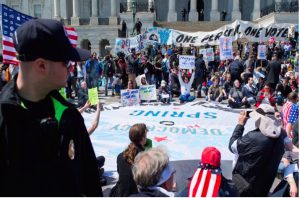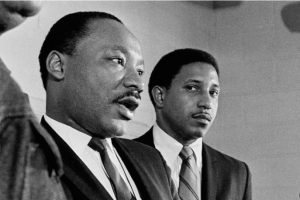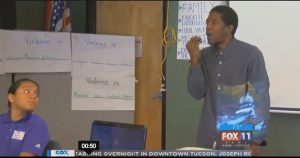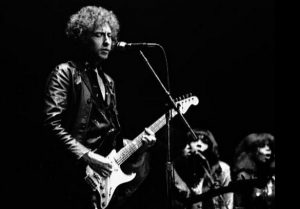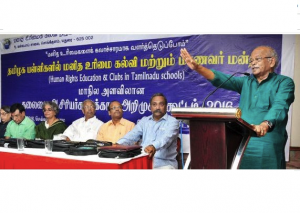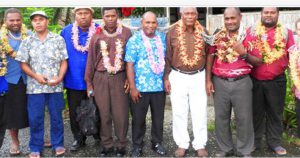EDUCATION FOR PEACE .
By Dr. Khursheed Ahmed, Editor, Living Gandhi Today
It rained all night and everyone was anxious that Gandhi Peace Festival would be rained out. But, the gods of rain were kind and while it was cloudy all day, the rain held off for Mahatma Gandhi’s 147th birthday in Hamilton, Ontario, Canada. This was the 24th year that over 250 people gathered at Hamilton City Hall despite cool autumn weather to celebrate this popular peace event. The theme this year was “Refugees and Sarvodaya – Opening Our Hearts and Homes”.

Everyone gathered around Gandhi’s statue to garland and reflect
(Click on image to enlarge)
Gandhi Peace Festival is jointly sponsored by India-Canada Society of Hamilton and McMaster University Faculty of Humanities and Centre for Peace Studies.
This year’s theme reflected the growing refugee crisis in many parts of the world and the high toll it has taken on millions of people. Dr. Chandrima Chakraborty, an Associate Professor in Department of English and Cultural Studies at McMaster University was the Master of Ceremonies. She warmly welcomed the audience and thanked the Gandhi Peace Festival Organizing Committee for their hard work, and also thanked the many volunteers, donors and supporters for making this event possible.
Joanna Frketich of the local newspaper, The Hamilton Spectator covered
the event with a very succinct article published on Monday, October 3rd, which nicely summed up the event. She wrote:
‘Canada can do better’ for refugees says peace festival speaker
The federal government was urged at Hamilton’s Gandhi Peace Festival to make a number of key improvements to how it deals with refugees. Better mental health support for traumatized refugees and funds to fight racism are badly needed, said Nora Melara-Lopez, social worker and co-ordinator of the emergency support committee for refugees at the North Hamilton Community Health Centre. Her keynote address Saturday to about 250 attending the 24th annual festival at City Hall urged the government to do more to help refugees work in their field after they arrive. She said increased funding for loans is needed while unfair charges need to be removed. She said delays in family reunification have to be reduced and backlogs cleared for those facing long waits for decisions both here and abroad. “I think Canada can do better,” she said. It’s significant at a time when more than 31,000 Syrian refuges have arrived in Canada, including more than 1,000 in Hamilton.
(Article continued in right column)
Question for this article:
What is the message to us today from Mahatma Gandhi?
(Article continued from left column)
Mayor Fred Eisenberger said bringing Syrian refugees to Canada “is the right thing to do.” He called the ongoing refugee crisis “a tragedy for our humankind.” He talked about the importance of peace and generosity during his address “notwithstanding things happening across the border.” He referenced the American presidential election as bringing out a lot of “racism, hatred and misogyny.” “In Canada we represent something different,” he said.
The youth community service award was given at the festival to Rahma Ahmed Abdi, who was born in Ethiopia but grew up in a refugee camp in Eretria. She came to Hamilton in 2009 at the age of 12. She now supports more than 20 students a week in the Empowerment Squared Homework Circle Program and is credited with more than tripling its enrolment. “I want to show that peace can come out of someone who has experienced extreme violence as a child,” she said.
The adult community service award went to Leo Johnson who was born in Liberia and spent his teen years and early adulthood in refugee camps before coming to Canada in 2006. He has since founded a successful not-for-profit organization called Empowerment Squared that helps refugees, immigrants and underprivileged communities. He has twice represented Hamilton at the Canadian Council for Refugees’ International Conference.
In addition to the speeches and awards, the Festival featured music, poetry and dances to warm up the spirits. The Colombian Refugee Association dazzled the audience with 20 dancers in traditional colourful costumes with lively music. This was followed by the popular Hamilton musician Kojo “Easy” Damptey, an Afro-Soul music producer, song writer, composer and poet, born and raised in Accra, Ghana. Three animated Hamilton Youth Poets also entertained the audience with their poetry. The last presentation after the Peace March was a beautiful performance of an Indian classical dance by Lamia Syed, who is well-known in Hamilton and has performed in previous festivals.
A number of groups providing services to refugees in Hamilton set up information tables. Darshana Limbachia, an avid Gandhi admirer, brought her impressive collection of books and photographs on Gandhi to display.
The cultural program was followed by people gathering around and garlanding the statue of Mahatma Gandhi on City Hall grounds. Leo Johnson, this year’s Community Service Award winner recounted the plight of refugees and the struggles they must go through because the international community tries to bring “peace” by bombing their cities and homes. He said “nobody would want to leave their homes if there was true peace”.
The peace march through downtown streets warmed the bodies and souls. There were many students and families that joined the traditional route, singing songs and chanting peace slogans. The walk also built up an appetite for a hot vegetarian lunch that awaited them, catered by India Village Restaurant and paid by donations from several long-time Gandhi Festival supporters.
